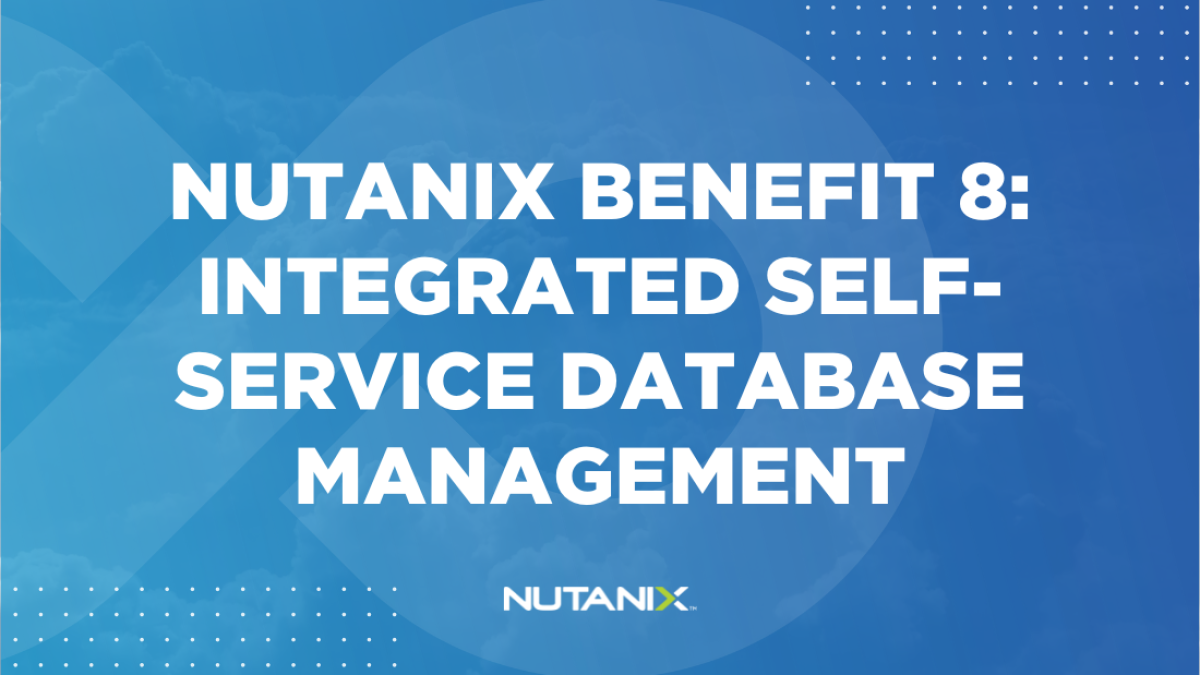At the beginning of the Nutanix Benefits series, we showed exactly how the Nutanix Cloud Platform is excellent for running critical apps and databases due to architectural decisions like dynamically distributed storage, automated app-aware data management, and granular and efficient snapshots. Nutanix also has a self-service database management platform known as the Nutanix Database Service or NDB, which takes advantage of these building blocks. NDB lets database administrators automate daily tasks and can help developers by enabling self-service database provisioning and by serving as a central automation point for database lifecycle management. With the performance and efficiency of Nutanix storage, NDB makes it even easier to deliver high-performing databases at scale.
Fast and Simple Database Provisioning
NDB simplifies database provisioning using predefined profiles customized to your environment. Software profiles, which are templates of the OS and database engine, allow you to maintain consistent software versions. You then use additional profiles to customize that deployment. Compute profiles offer flexible options for memory and CPU to meet your database requirements. Network profiles allow you to place those databases on the correct network, whether it is dev, test, or production. Database parameters profiles customize each database engine depending on the size of your database or memory requirements. You can use this to limit the memory being used by MSSQL on Windows or the max worker processes in PostgreSQL. If you are deploying MSSQL on Windows, you can even use domain profiles to join the domain and a custom OU if needed.
Developer Self-Service
NDB gives DBAs the ability to enable their users, namely application developers, self-service provisioning for both dev/test and production use via API integration with popular infrastructure management and development tools like ServiceNow, Ansible, and Terraform. This means developers can request and deploy new database instances with just a few clicks or commands and without needing to use a separate console or bothering DBAs. DBAs can still control the parameters of any new database deployment (see above), but empower developers to quickly and easily access databases to support new applications and services they are building.
Copy Data Management (CDM)
NDB lets you manage the deployment and refresh of clones with easy steps. Clones are space efficient because NDB uses the Nutanix Cloud Platform’s snapshot technology discussed in the granular and efficient snapshot blog post. As a result, clones are created and refreshed quickly no matter the size of the source database. The database is re-created as a thin clone, requiring minimal space, unlike standard database tools and scripts which might make a full copy of the source. NDB also lets you set a refresh schedule to keep the clones up to date with the source, as well as a removal schedule to time limit the clone.
Database Protection
Database protection with NDB configures specific Service Level Agreements (SLAs) to fit the recovery point objective (RPO) and recovery time objective (RTO) of your environment. This allows NDB to provide point-in-time recovery down to the second. With in-place recovery, NDB checks for any local logs on the db server and recovers those with next to no data loss. Not only is recovery up-to-date, it’s also quick because of native Nutanix snapshots, even for the largest databases. NDB also utilizes the built-in protection domains discussed in Enterprise Grade Replication and Disaster Recovery to replicate your backups to other Nutanix clusters, whether they are running in your local data center, a remote data center, or on Nutanix Cloud Clusters (NC2.)
Patching
NDB uses software profiles for database patching to keep your databases secure and optimized. When a new database is provisioned, it will be on your current environment’s database version to maintain consistency and stop version sprawl. For pre-production patch testing with Linux-based database engines, choose a server that NDB manages and apply the database patches. Once testing is successful, make a new version of the software profile. With MSSQL you would also test your patches before making a new version of the software profile, but you would then use the cumulative update file or patch file to create a new version of the software profile. NDB will show available updates for any database server using the software profile as soon as the new profile version is published. You can choose to update immediately or schedule it for a later date.
Why Does This Matter?
Nutanix believes that enterprise infrastructure should be powerful and simple to manage simultaneously. The Nutanix Database Service brings the same commitment to database management by leveraging the strong core of the Nutanix Cloud Platform. NDB allows organizations to streamline their database management and have a consistent, reliable, and secure database environment. NDB also stands apart by supporting some of the most popular database engines in the world. including PostgreSQL, Microsoft SQL Server, Oracle, MongoDB, MariaDB and MySQL. In summary:
- The provisioning engine allows for quick and consistent deployment of new databases customized to organizations’ requirements.
- Self-service provisioning means developers no longer have to wait days or weeks for a new database but can access their database of choice in minutes or hours to support agile, iterative software development practices and speed time-to-market.
- CDM helps organizations respond quickly to requests for new or refreshed clones, which can speed up testing and adoption of new features or software versions, which will keep security administrators, users, and developers happier.
- Database protection allows for quick data recovery, which can be crucial in critical moments.
- Patching workflows keep your environment more secure because it limits configuration sprawl and keeps your environment more consistent.

